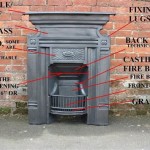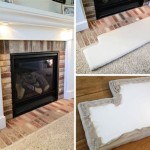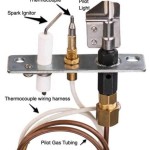How To Install Ledgestone Over Brick Fireplace
Installing ledgestone over a brick fireplace is a popular way to update its appearance and create a more modern or rustic aesthetic. This project enhances the visual appeal of a living space while potentially increasing the home's value. Careful planning and execution are crucial for a successful and long-lasting installation. This article outlines the necessary steps to install ledgestone over an existing brick fireplace, covering preparation, installation, and finishing touches.
Preparation is Paramount
Thorough preparation is the foundation of any successful ledgestone installation. This stage involves assessing the condition of the existing brick, gathering the necessary tools and materials, and ensuring the surface is properly prepared to receive the ledgestone.
The first step is to inspect the brick fireplace for any damage, such as cracks, loose bricks, or crumbling mortar. These issues must be addressed before proceeding with the ledgestone installation. Cracks in the brick can be filled with a masonry crack filler, and loose bricks should be re-mortared. Crumbling mortar can be removed and replaced with fresh mortar. This ensures a stable and sound base for the ledgestone.
Cleaning the surface of the brick is also essential. Over time, brick fireplaces accumulate soot, dust, and grime. These contaminants can interfere with the adhesion of the mortar and compromise the longevity of the ledgestone installation. Use a wire brush and a solution of trisodium phosphate (TSP) or a similar degreasing cleaner to thoroughly scrub the brick surface. Rinse the surface thoroughly with clean water and allow it to dry completely before proceeding. Ensure proper ventilation when using TSP, and wear appropriate personal protective equipment, such as gloves and eye protection.
Selecting the appropriate ledgestone is another critical aspect of preparation. Ledgestone is available in a variety of materials, colors, and textures. Consider the style of the home and the desired aesthetic when making your selection. Natural stone ledgestone offers a unique and durable option, while manufactured stone ledgestone provides a more consistent appearance and is often more affordable. Measure the surface area of the fireplace to determine the amount of ledgestone required. Add an extra 10-15% to account for cuts and waste.
Gather all the necessary tools and materials before starting the installation. These typically include: ledgestone, thin-set mortar, a notched trowel, a wet saw with a diamond blade (for cutting stone), a rubber mallet, a level, spacers, a sponge, a bucket, a mixing paddle, safety glasses, gloves, and a dust mask. A mortarboard or hawk is also helpful for holding mortar during application.
Applying a scratch coat of mortar is often recommended, especially if the brick surface is very smooth or uneven. This provides a better bonding surface for the ledgestone. Mix the thin-set mortar according to the manufacturer's instructions. Apply a thin, even layer of mortar to the brick surface using a trowel. Score the surface of the mortar with the notched trowel to create ridges. This will increase the surface area for adhesion. Allow the scratch coat to dry completely before proceeding to the ledgestone installation.
Ledgestone Installation Process
With the preparation complete, the actual installation of the ledgestone commences. This process requires careful attention to detail to ensure a professional and aesthetically pleasing result.
Begin by dry-fitting the ledgestone. Lay out the ledgestone pieces on the floor in the desired pattern. This allows you to visualize the final appearance and make any necessary adjustments before adhering the stone to the fireplace. Consider the natural variations in color and texture of the stone and arrange them to create a balanced and visually appealing design. Pay attention to the joint lines and ensure they are consistent and aesthetically pleasing. This dry-fitting process helps identify any cutting that may be required.
Cutting the ledgestone is often necessary to fit the dimensions of the fireplace and create a finished edge. Use a wet saw with a diamond blade to cut the stone. The wet saw will help minimize dust and ensure a clean, precise cut. Wear safety glasses and a dust mask when cutting ledgestone. Measure carefully and mark the cutting line on the stone before cutting. Make slow, steady cuts to avoid chipping or cracking the stone.
Apply the thin-set mortar to the back of the ledgestone using the notched trowel. Apply enough mortar to ensure good contact with the brick surface, but avoid applying too much, as this can cause the mortar to squeeze out between the stones. The ridges created by the notched trowel will help distribute the mortar evenly and provide a strong bond. Ensure the entire back of the ledgestone is covered with mortar.
Press the ledgestone firmly into place on the fireplace, aligning it with the desired pattern. Use a rubber mallet to gently tap the stone into position, ensuring it is level and flush with the surrounding stones. Maintain consistent joint lines between the stones. Use spacers to maintain uniform joint spacing. This helps create a professional and aesthetically pleasing appearance. Start at the bottom of the fireplace and work your way up, one row at a time. This prevents the weight of the upper rows from pulling down on the lower rows before the mortar has had a chance to set.
Continuously check the level of the installed ledgestone using a level. Make adjustments as needed to ensure the stones are level and plumb. Any unevenness will be more noticeable once the installation is complete. Periodically step back and view the installation from a distance to ensure the overall appearance is balanced and aesthetically pleasing.
Remove any excess mortar that squeezes out between the stones immediately. Use a small trowel or a putty knife to carefully remove the excess mortar. This prevents the mortar from drying on the surface of the stone, which can be difficult to remove later. Wipe the surface of the stone with a damp sponge to remove any remaining mortar residue. Be careful not to disturb the newly installed stones.
Allow the mortar to cure completely according to the manufacturer's instructions. This typically takes 24-48 hours. Avoid disturbing the installed ledgestone during this time. The curing process allows the mortar to fully harden and bond with the stone and the brick surface, ensuring a strong and durable installation.
Finishing Touches and Long-Term Maintenance
Once the mortar has cured, the final steps involve cleaning the surface, applying a sealant (optional), and implementing a regular maintenance routine to preserve the appearance and integrity of the ledgestone installation.
After the mortar has cured, inspect the installation for any remaining mortar residue or imperfections. Use a stiff brush and a mild detergent solution to gently scrub the surface of the ledgestone. Rinse thoroughly with clean water and allow the surface to dry completely. Be careful not to use harsh chemicals or abrasive cleaners, as these can damage the surface of the stone. A pressure washer is generally not recommended for cleaning ledgestone, as the high pressure can dislodge the stones or damage the mortar joints.
Applying a sealant to the ledgestone is optional but often recommended, especially for exterior installations or fireplaces exposed to moisture. A sealant will help protect the stone from water damage, staining, and fading. Choose a sealant specifically designed for use on natural stone or manufactured stone. Apply the sealant according to the manufacturer's instructions. Typically, this involves applying a thin, even coat of sealant to the surface of the stone using a brush or a sprayer. Allow the sealant to dry completely before using the fireplace.
Regular maintenance is essential to preserve the appearance and longevity of the ledgestone installation. Periodically inspect the installation for any signs of damage, such as cracks, loose stones, or crumbling mortar. Address any issues promptly to prevent further damage. Clean the surface of the ledgestone regularly to remove dust, dirt, and grime. Use a soft brush and a mild detergent solution. Avoid using harsh chemicals or abrasive cleaners. Reapply sealant every few years, as needed, to maintain its protective properties.
By following these steps carefully, homeowners can successfully install ledgestone over a brick fireplace, transforming the look of their fireplace and enhancing the aesthetic appeal of their living space. Remember to prioritize preparation, meticulous installation, and ongoing maintenance for a lasting and visually stunning result.

Fireplace Makeover Featuring Ledgestone The Cultured Stoners

Transform Your Home Stone Veneer Over Brick Fireplace Guide

Fireplace Facelift Using Natural Stone Veneer
.jpg?strip=all)
Brick Fireplace Gets Stone Veneer Makeover

Can Stone Veneer Be Applied Over Brick Deluca Masonry Construction

How To Install Thin Brick Veneers On Your Fireplace

Building A Stone Veneer Fireplace Over The Brick

Transform Your Brick Fireplace
Indoor Installation Of Ledgestone Ceramic Tile Advice Forums John Bridge

How To Cover A Brick Fireplace With Stone








